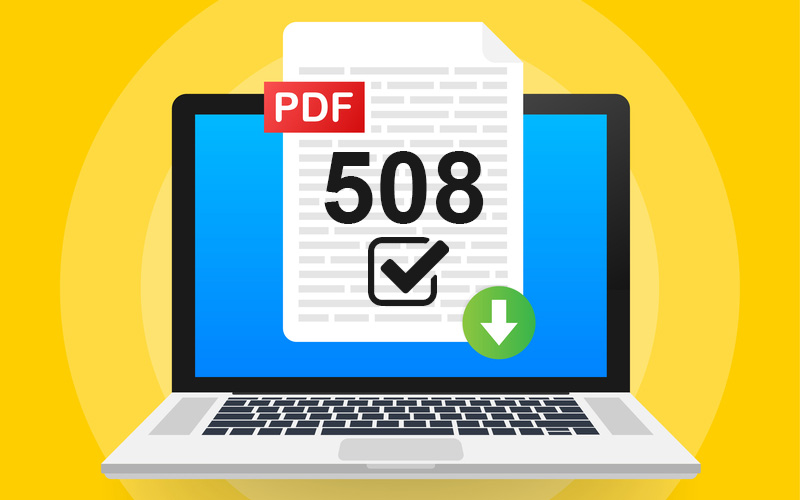Introducing the PDF 508 Compliance Checker, the ultimate solution for ensuring your PDF files are accessible and compliant with web accessibility standards. In today’s digital era, accessibility is more important than ever. With PDF files being widely used across various industries, it’s crucial to ensure that everyone, including people with disabilities, can access and interact with your documents.
The PDF 508 Compliance Checker is a powerful tool that scans your PDF files and highlights any accessibility issues, making it easier for you to identify and fix them. From alt text for images to proper headings and tags, this tool checks all the essential elements required for compliance with Section 508 of the Rehabilitation Act and WCAG 2.0 accessibility guidelines.
Designed with user-friendliness in mind, the PDF 508 Compliance Checker is suitable for both beginners and experts. Its intuitive interface and comprehensive reports make accessibility testing a breeze, saving you time and effort. Ensure equal access to information and avoid any legal ramifications by incorporating the PDF 508 Compliance Checker into your workflow. Experience peace of mind knowing your PDFs are accessible to all users.
What is PDF 508 Compliance?
In today’s digital landscape, accessibility is a fundamental aspect of web design and development. It ensures that individuals with disabilities can access and interact with digital content, including PDF files. PDF 508 Compliance refers to the adherence of PDF files to the accessibility standards outlined in Section 508 of the Rehabilitation Act and WCAG 2.0 guidelines.
PDF files are a popular format for sharing and distributing documents due to their versatility and consistent formatting across different devices and platforms. However, without proper consideration for accessibility, PDF files can create barriers for individuals with disabilities, hindering their ability to read, navigate, and understand the content.
To address this issue, the PDF 508 Compliance Checker has emerged as a valuable tool for businesses and organizations. This tool scans PDF files and identifies accessibility issues, allowing for timely fixes and ensuring compliance with accessibility standards.
Why is PDF 508 Compliance important?
Accessibility is not just a moral imperative; it is also a legal requirement. Failure to comply with accessibility standards can result in legal ramifications, including lawsuits and fines. Moreover, ensuring PDF 508 Compliance demonstrates a commitment to inclusivity and equal access to information for all users.
By making PDF files accessible, you expand your reach to a wider audience, including individuals with disabilities who may rely on assistive technologies like screen readers or alternative input devices. Additionally, accessible PDF files improve the overall user experience for everyone, as they are designed with clear structure, readable text, and meaningful visuals.
Understanding Section 508 of the Rehabilitation Act
Section 508 of the Rehabilitation Act is a U.S. federal law that mandates federal agencies to make their electronic and information technology accessible to individuals with disabilities. This law applies to all federal agencies, as well as organizations that receive federal funding or contracts.
The key objective of Section 508 is to eliminate barriers in communication and information technology, ensuring equal access and opportunity for individuals with disabilities. It sets specific requirements for different types of digital content, including PDF files, to ensure they can be accessed and used by individuals with disabilities.
To comply with Section 508, PDF files must meet specific guidelines related to alternative text for images, proper headings and tags, color contrast, and more. These guidelines are designed to enable individuals with disabilities to navigate, understand, and interact with the content effectively.
PDF 508 Compliance requirements
To ensure PDF 508 Compliance, it is essential to understand the specific requirements outlined in Section 508 and WCAG 2.0. Some of the key requirements include:
1. Alternative Text: PDF files should include alternative text for images, providing a textual description of the visual content for individuals who cannot see the images.
2. Document Structure: PDF files should have a logical structure, including headings, subheadings, and properly nested sections. This structure allows assistive technologies to navigate the document effectively.
3. Color Contrast: Text and images within PDF files should have sufficient color contrast to ensure readability for individuals with visual impairments.
4. Keyboard Accessibility: PDF files should be navigable using a keyboard alone, without relying on mouse interactions. This ensures individuals with mobility impairments can access and interact with the content.
5. Forms and Interactive Elements: PDF forms and interactive elements must be accessible to individuals using assistive technologies, such as screen readers or screen magnifiers.
How to check PDF 508 Compliance
Checking PDF 508 Compliance can be a complex process, but with the right tools and techniques, it becomes more manageable. Here are some steps to help you ensure your PDF files meet accessibility standards:
1. Use the PDF 508 Compliance Checker: The PDF 508 Compliance Checker mentioned earlier is a powerful tool that scans your PDF files and generates detailed reports on accessibility issues. This tool highlights areas that need improvement, making it easier for you to address the problems.
2. Manual Inspection: While automated tools can identify many accessibility issues, manual inspection is necessary to ensure complete compliance. Review the PDF file carefully, examining elements such as alt text, headings, tags, color contrast, and interactive elements.
3. User Testing: Involve individuals with disabilities in the testing process to gain valuable insights into the accessibility of your PDF files. Their feedback can help you identify any usability issues and make necessary adjustments.
4. Continuous Improvement: Accessibility is an ongoing process. Regularly review and update your PDF files to ensure they remain accessible as technology and guidelines evolve.
Tools for PDF 508 Compliance checking
In addition to the PDF 508 Compliance Checker mentioned earlier, several other tools can assist you in ensuring PDF accessibility. These tools provide a range of features, including automated checks, manual inspections, and detailed reports. Here are a few notable options:
1. Adobe Acrobat Pro: Adobe Acrobat Pro offers built-in accessibility features and tools for checking and enhancing PDF accessibility. It provides a comprehensive set of accessibility options to help you create and validate accessible PDF files.
2. CommonLook PDF: CommonLook PDF is a professional tool designed specifically for PDF accessibility. It offers automated checks, manual inspection capabilities, and remediation features to ensure your PDF files meet accessibility standards.
3. PAC 2: PAC 2 (PDF Accessibility Checker) is a free tool developed by the Access for All Foundation. It performs automated checks on PDF files and generates detailed reports highlighting accessibility issues.
Best practices for achieving PDF 508 Compliance
While automated tools can assist in identifying accessibility issues, it’s essential to follow best practices to ensure your PDF files are fully compliant. Here are some tips to help you achieve PDF 508 Compliance:
1. Properly tag the document structure: Use headings, subheadings, lists, and other structural elements to create a logical document hierarchy. This allows assistive technologies to navigate the document effectively.
2. Provide alternative text for images: Include descriptive alt text for images, charts, and graphs. The alt text should convey the meaning and context of the visual content.
3. Ensure color contrast: Use colors with sufficient contrast to ensure readability. Avoid relying solely on color to convey information.
4. Use accessible fonts and formatting: Choose fonts that are easy to read, and avoid using excessive formatting, such as all caps or italics. Properly format tables, lists, and other elements for improved accessibility.
5. Test with assistive technologies: Use screen readers, screen magnifiers, and other assistive technologies to test the accessibility of your PDF files. This allows you to experience the content from the perspective of individuals with disabilities.
Common issues with PDF 508 Compliance and how to fix them
While striving for PDF 508 Compliance, you may encounter common issues that need to be addressed. Here are a few examples of such issues and their potential solutions:
1. Missing or incorrect alt text: If images lack alternative text or have inaccurate descriptions, ensure that each image has a concise and meaningful description to convey the intended information.
2. Improper document structure: If the document lacks proper headings, subheadings, or a logical structure, make the necessary adjustments to ensure a clear hierarchy and ease of navigation.
3. Insufficient color contrast: If the color contrast within the PDF file is inadequate, modify the colors to meet accessibility guidelines, ensuring text and images are easily discernible.
4. Complex tables or forms: If tables or forms are not properly structured or labeled, revise them to enhance accessibility. Add appropriate headings, column and row labels, and form field descriptions.
5. Inaccessible links: If hyperlinks are not descriptive or do not indicate their purpose, update them with meaningful link text that clearly communicates the destination or action.
Benefits of PDF 508 Compliance
Ensuring PDF 508 Compliance offers numerous benefits beyond legal compliance. Here are some key advantages:
1. Expanded audience reach: Accessible PDF files enable individuals with disabilities to access and interact with your content, expanding your audience and potential customer base.
2. Improved user experience: Well-structured and accessible PDF files enhance the overall user experience for all users, regardless of their abilities. This includes easier navigation, better readability, and more efficient interaction.
3. Positive brand image: Demonstrating a commitment to accessibility can enhance your brand image and reputation. It shows that you value inclusivity and equal access to information.
4. Legal compliance: Compliance with Section 508 of the Rehabilitation Act and other accessibility standards helps protect your organization from potential legal issues and ensures you meet governmental requirements.
Conclusion
In an increasingly digital world, accessibility is not just a nice-to-have feature; it’s a necessity. PDF 508 Compliance is crucial for ensuring equal access to information for individuals with disabilities. By utilizing tools such as the PDF 508 Compliance Checker and following best practices, you can create accessible PDF files that meet the requirements of Section 508 and WCAG 2.0 guidelines.
Take the necessary steps to ensure your PDF files are accessible to all users. By doing so, you not only comply with legal obligations but also create a positive user experience and improve your brand’s reputation. Prioritize accessibility, and make a difference in the lives of individuals with disabilities by embracing PDF 508 Compliance.
Lenovo Laptops Factory Reset With and Without Novo Keys
Best Data Recovery Software of 2023
Laptop Repair Made Easy: The Complete Guide for Beginners to Experts




